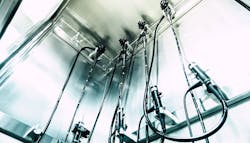Decentralized processes expose problems for scope storage
Endoscope storage is a practice that deserves careful attention and must never be taken lightly. Contaminated flexible and semi-rigid endoscopes have been associated with more healthcare-associated infections than any other medical device.1 The reprocessing of such devices has a narrow margin of safety, and deviations from the recommended reprocessing procedures or manufacturer instructions for use (IFU) can increase the risk of infection, or worse.2
The Association for the Advancement of Medical Instrumentation’s (AAMI’s) updated ANSI/AAMI ST91:2021 flexible and semi-rigid endoscope processing in health care facilities standard addresses concerns about endoscope cleanliness, new technologies, and patient safety. In addition to accounting for regulatory concerns, the new standard has extensive appendices citing peer-reviewed research and data to support the new recommendations.
A proper storage environment is one that protects the endoscope from damage and minimizes environmental contamination. With decentralized control and ownership of medical devices in many healthcare organizations, it is not always easy to maintain consistent practice standards. Over time, monitoring and cleaning processes, as well as appropriate storage of medical devices, can lead to process variations over prolonged periods. Although the storage cabinets should be cleaned regularly (daily and weekly), filter changes are more complicated, requiring specific skills and resources (knowledge, tools or equipment) to be performed safely and effectively. Further, in many healthcare organizations, Facilities Engineering regularly maintains other filters, such as ventilation and water filters for automated endoscope reprocessors (AERs). In some cases, the filters in endoscope storage cabinets may be overlooked, and end users may unknowingly fail to maintain their cabinets properly.
Hospital’s scope storage review spotlights concerns
As a result of ANSI/AAMI ST91:2021, a large U.S. teaching hospital reviewed endoscope storage throughout its system, and the findings were surprising. Not only were issues identified within the endoscopy department, but problems and unexpected issues regarding scope storage also occurred outside the department. Specifically, the in-depth assessment found: Scopes stored in transport containers (clean-a-scope bins); scopes stored in carpeted offices with medical supplies; inconsistent temperature and humidity monitoring; multiple cabinet manufacturers/generational storage options; fans installed improperly, with unfiltered room air drawn from vents on the floor discharging through the top; dirty filters unchanged for years; numerous cabinet fan systems no longer functioning or had no HEPA filter option; roller door cabinets broken or nonfunctioning; dust accumulation near roller mechanisms and on back of the door; several departments’ failure to perform recommended preventative maintenance; inconsistency format and frequency of cabinet cleaning documentation; lack of knowledge of basic requirements for scope storage and maintenance; and nonexistent cleaning logs (incorrect year or incomplete).
To improve compliance, subject matter experts from Endoscopy, Sterile Processing, and Facilities Engineering formed a task force to initiate the upgrade/replacement of storage cabinets. First, Endoscopy and SP reviewed their records to determine which units they supported in HLD and sterilization. Those units were notified of the situation and asked to validate the type of scope(s) they stored and maintained. They also were asked to provide the make and model of the scope cabinets, and photos, where appropriate. Most of the identified issues could easily be remedied through the installation of new doors, fans and filter system to ensure the circulation of HEPA-filtered or instrument air through the cabinet at passively or via continuous positive pressure. Monitoring of storage time could prove burdensome to some departments that utilized the scopes infrequently, as unused HLD and LCS scopes require routine reprocessing at certain time intervals. Additionally, cabinets meeting standard EN 16442-2015 [47] have specific manufacturer-recommended safe storage intervals based on validated test methods, which may add confusion if an organization uses different varieties of storage cabinets. In some cases, where it made sense, single-use and sterilized endoscopes could be used for those areas; therefore, funding for updating or purchasing new storage was redirected toward new devices.
The interdisciplinary team should be able to help answer the following: Should the current scope inventory be kept (based on age and maintenance history)? Are new devices available with better features? Have IFU changed regarding HLD and sterilization options? Is SP capable of sterilizing a higher volume of endoscopes? Are single-use devices available in sufficient qualities to meet therapeutic needs and align with the organization’s environmental impact goals? Many older cabinets can be easily upgraded to positive pressure with HEPA filtration, but upgrades must be done in a manner supported by the vendor. Some vendors have upgrades to convert conventional endoscope storage cabinets to drying cabinets, for example.
To further enhance scope storage safety, the following steps should be performed: Before use, read and follow the IFU for each endoscope storage cabinet; ensure the cabinet is cleaned per the IFU and with approved hospital-grade solutions or disinfecting wipes (document the cleaning); visually inspect the drip tray for evidence of insufficient drying before routine cleaning; change HEPA filters according to the IFU (and document); maintain cleaning and filter change logs, based on the organization’s document-retention policies; and develop consistent scope storage policies and procedures in all appropriate areas.
Conclusion
Endoscopy and SP professionals must remain vigilant and ensure that all practices and equipment surrounding endoscope management, processing and storage are performed safely and consistently and in line with the latest standards, IFU and facility policies. Storage cabinets are critical to ensuring that endoscopes remain protected and free from dust, debris and other potential contaminants.
References
1. https://www.jointcommission.org/resources/news-and-multimedia/newsletters/newsletters/quick-safety/quick-safety-issue-11/#.YsF88i-B0kg
2. https://www.jointcommission.org/resources/news-and-multimedia/newsletters/newsletters/quick-safety/quick-safety-issue-11/superbug-reveals-challenges-with-highlevel-disinfection/#.YsF9WC-B0kg
About the Author

David Taylor
Principal, Resolute Advisory Group LLC
David L. Taylor, MSN, RN, CNOR is an independent hospital and ambulatory surgery center consultant and the principal of Resolute Advisory Group LLC, in San Antonio, Texas.
